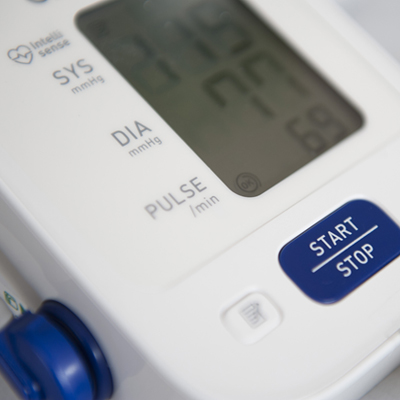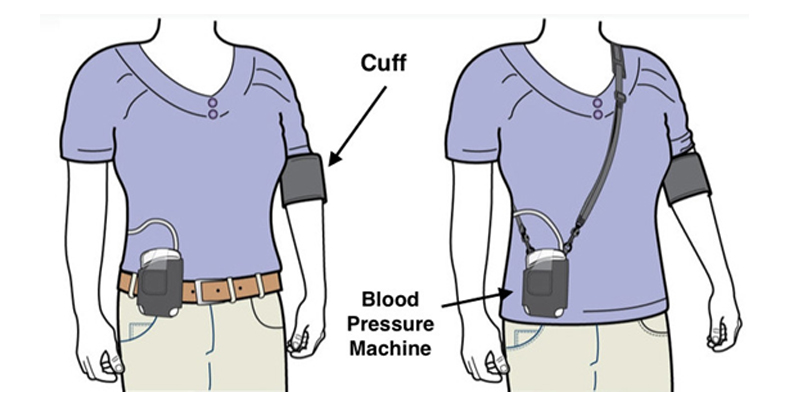
24 Hour Blood Pressure Monitor: Monitor Your Blood Pressure 24/7 with Ease!
Ambulatory Blood Pressure Monitoring (ABPM) is a test done to record your blood pressure at fixed intervals throughout a 24 hr period while you move around, living your normal everyday life. It uses a small blood pressure machine that is attached to a belt around your body and is connected via a tube to a cuff wrapped around your upper arm. It is small enough not to obstruct normal daily life while you can even sleep with it on.

The Importance of Regular Blood Pressure Check-Ups: Catching Problems Early for Better Health
By measuring your blood pressure at regular intervals over 24 hours, your doctor is able to get a clear picture of how your blood pressure fluctuates throughout the day and night and how well it is controlled. There are a number of reasons why your doctor might suggest this test:
• To confirm if you do suffer from high blood pressure and how high are the readings over a 24 hr period.
• If your blood pressure readings are always high in doctors clinic/ surgery, your doctor may want to know if it is actually lower outside the clinic – this is called the “white coat effect”.
• Your doctor may want to see how large are the fluctuations in your blood pressure throughout the 24 hr period.
• To see how well the medicines are working, and to make sure they are controlling your blood pressure throughout the day and night.
• To see if your blood pressure stays high at night. If this is the case, your doctor may want to change or adjust your medicines.
Procedure:
• You need to be booked for this test and there may be a small fee charged as this test is still not reimbursed by Medicare in Australia.
• The blood pressure cuff is wrapped and fixed around your upper arm – either arm can be used.
• The digital blood pressure machine itself is attached to a belt around your waist.
• Technician checks that battery life is sufficient for 24 hrs and checks if the machine operates well.
• The cuff inflates every 30-60 minutes as per the settings and then slowly deflates to record the blood pressure in its memory. This is no different from any other blood pressure machine.
• The blood pressure is recorded throughout the 24 hr period. Please do not switch it off at night as night time readings are equally important.
• The machine is fitted at the Heartwest rooms.
• Because the test is being carried out to find out what your normal daily blood pressure is, it is important to carry on with your normal routine and do all the things you would usually do.
• The only things you should avoid doing for the day are swimming and having a bath or shower with the machine attached. It may be best to avoid vigorous physical exertion also, while the cuff is being inflated.
• At the completion of 24 hours you can either remove the machine and cuff yourself or come back to our HeartWest rooms where staff will take it off. If it’s worn on a Friday please make sure that it’s taken off and switched off after 24 hrs on Saturday and returned on Monday for the machine data to be analysed.
• A formal report will then be completed by the reporting cardiologist and sent to your referring doctor whom you should see to get the results.
Helpful hints:
• To allow the machine to work properly, it is important to make sure that the tube from machine to the cuff is not twisted or bent.
• Just before the machine is about to take a reading, it will beep. When this happens you should try to relax, keep your arm steady and sit down if possible.
• You will also be asked to keep a diary of what you were doing just before the reading was taken, what time you went to sleep and what time did you get up in the morning.
• Some people find 24-hour ABPM distracting and uncomfortable: if you feel like this when the readings are being taken, please tell your doctor about this as it may affect your readings.
Interpreting Your 24 Hour Blood Pressure Data: Understanding the Numbers and Trends
Interpreting your 24-hour blood pressure data should be done in consultation with your healthcare provider, as they can provide personalised guidance based on your medical history, risk factors, and specific circumstances. This process involves gathering and reading the numbers and trends recorded throughout the monitoring period. Here are the steps involved in interpreting your data:
Obtain the Data
Your healthcare provider will provide you with a report or a printout of your 24-hour blood pressure monitoring data. This report typically includes a graph or table showing your readings over the entire monitoring period.
Understand the Numbers
Blood pressure is measured using two numbers: systolic pressure (the higher number) and diastolic pressure (the lower number). For example, a blood pressure reading of 120/80 mmHg indicates a systolic pressure of 120 mmHg and a diastolic pressure of 80 mmHg.
Identify Normal Blood Pressure Range
Normal blood pressure is typically defined as a systolic pressure below 120 mmHg and a diastolic pressure below 80 mmHg. However, it’s essential to consider individual factors and any specific recommendations from your healthcare provider.
Look for Patterns and Trends
Examine the graph or table provided, and identify patterns or trends in your blood pressure readings. Look for consistent ranges of blood pressure or fluctuations that occur throughout the day and night.
Assess Blood Pressure Variability
Variability refers to the changes in blood pressure readings over time. High blood pressure variability may indicate increased cardiovascular risk. Analyse the range between your highest and lowest readings during the monitoring period.
Note the Time of Day
Pay attention to the timestamps associated with your readings. This information helps identify any patterns related to specific times of the day or activities. It can also reveal if there are any nocturnal changes in blood pressure while you sleep.
Compare with Target Blood Pressure
Your healthcare provider may have specific target ranges for you, depending on your individual circumstances and any existing medical conditions. Compare your recorded BP readings with these target ranges to determine if your blood pressure is within the desired goals.
Consider Symptoms and Lifestyle Factors
Take note of any symptoms you experienced during the monitoring period, such as dizziness, chest pain, or shortness of breath. Additionally, consider any lifestyle factors that may influence your BP, such as physical activity, stress levels, or medication use.
Discuss with Your Healthcare Provider
Schedule an appointment with your healthcare provider to discuss the results of your 24-hour blood pressure monitoring. They will provide a comprehensive interpretation, considering all the factors mentioned above, and make appropriate recommendations regarding treatment, lifestyle modifications, or further diagnostic tests.
